With the long rains now here with us, now is the best time to plant trees. Often, I meet people who are discouraged by the pittance of their spaces; a balcony or a few feet across are all they have for outdoor space. If this is your situation, do not be discouraged. In this article, we bring you a list of best small trees that will grow well even in the smallest of spaces.
Why should you go for small Trees ?
For small gardens, small or slow growing trees should be the first consideration. Trees eventually grow into their normal sizes at maturity and the straggly seedling you buy today will soon be a giant tree tomorrow. And there is no greater nuisance than having a large tree in a small garden. The roots, branches and leaves soon become a powder keg-damaging the roof, blocking the gutter, cracking the pavement, blocking pipes and so forth. And don’t forget that troublesome neighbor who will cause trouble if your trde branches overhang their property. Luckily small and medium size trees exist to fit any garden.
Select the Right Small Tree Species
In choosing a tree to plant always select a native tree or one that has indigenized to your location. The best way to tell a tree that will grow in your area is to look at the ones presently growing in your locality. However it is possible that the tree you fancy is not locally grown. In this case, find out the growing requirements of the tree and if they are similar to your area, go ahead and purchase it.

Planting Your Small Trees
Site your small tree in an open place. Don’t place it adjacent to the house, over water pipes or under power lines. If you do, it won’t have room to stretch its limbs or roots. Dig a hole 2-4 times wide than the root ball and 1 and half times as deep. Add organic matter to the base. I can’t emphasize the importance of organic matter at planting enough. Nail the stake off centre. Plant the tree, backfilling with soil and organic matter. Always ensure the level at which the soil was in the planting bag is the same level at planting. If you plant shallowly you risk exposing the roots and your tree will constantly require watering. Exposed roots dry out the tree faster. If you plant too deep, the buried part of the stem may start rotting under the soil. Firm up the tree and stake if necessary. Water regularly until established.
We recommend that you plant a tree one half of the maximum tree height away from the house. For tree growing to 5metres plant it at least 2.5 meters a way from the house. This is because tree roots can often grow beyond a trees canopy.
If you have a small garden, here are the trees you should go for;-
- Thika palm (Felicias decipens) (Japanese fern tree)
Loved for its lush green and striking foliage. Its compact shape ensures that it is self limiting and ideal for a small space. The leaves appear fern-like giving it its local name Thika palm. Flowers, white with a pink tint are not a major feature as they are hidden in the dense foliage. And many homeowners get surprised when I tell them the tree does have flowers!
Planted in a row, Thika palm works as a windbreaks, screens and noise mufflers. A single specimen provides good shade in a lawn. It is slow growing and will rarely reach 10m in urban gardens. Thika palm is propagated from seeds. It occurs naturally in small parts of East African highlands, Sri lanka and Southern India.

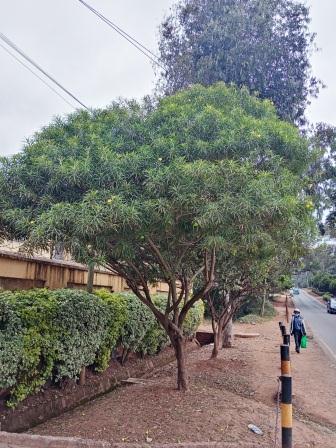
2. Theveita Peruviana
Theveita occurs in 8 species of evergreen shrubs and trees from Northern and Southern America and the West Indies. The most common Theveita locally is the peruviana.
The tree has showy funnel shaped flowers with five overlapping petals. The seeds of Theveita are highly toxic. You can raise seedlings from cuttings or seeds. Theveita is trouble free once planted.
I had not known that it forms nice hedges until I went to a village in Kirinyaga and found it giving a very nice hedge.
3. Mimosa tree (Acacia podalyriiforia), Queensland Silver wattle
An erect loosely branched evergreen hairy tree growing to 3-5 metres tall. Grown for its attractive grey-like foliage. The rich yellow flower heads are spherical and fragrant. Grow from seeds after soaking in warm water until swollen. It can an also be propagated from semi-ripe cuttings.
Mimosa tree is from the Acacia family found in Kenya, Southern Africa, Polynesia and Australia.
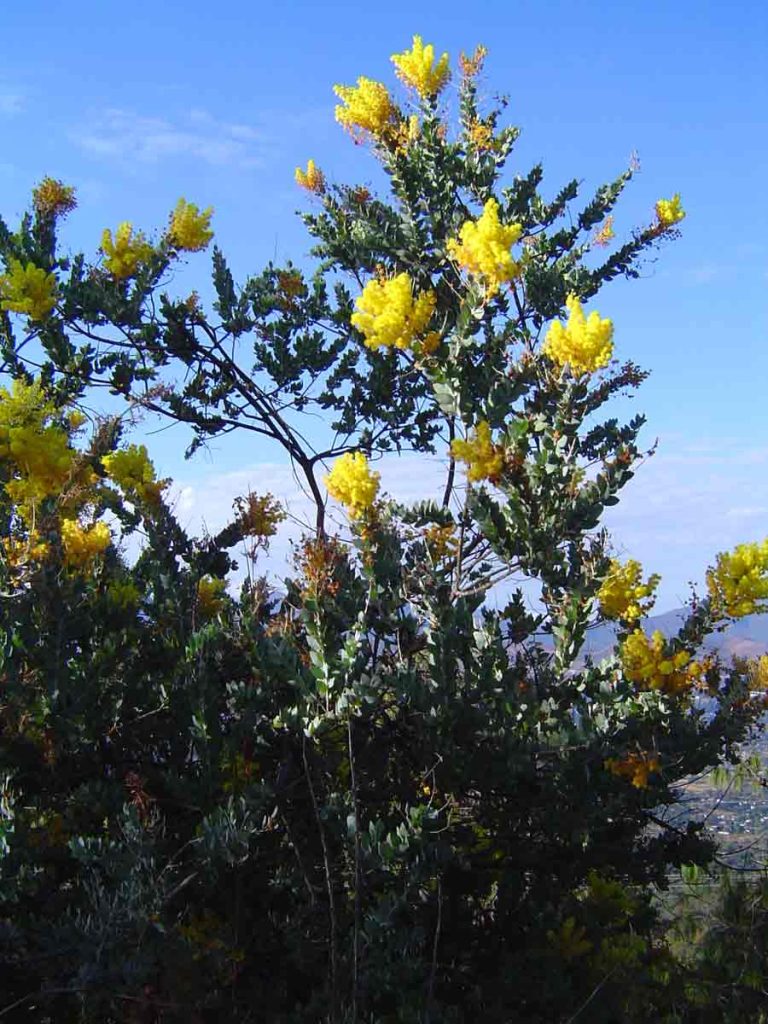
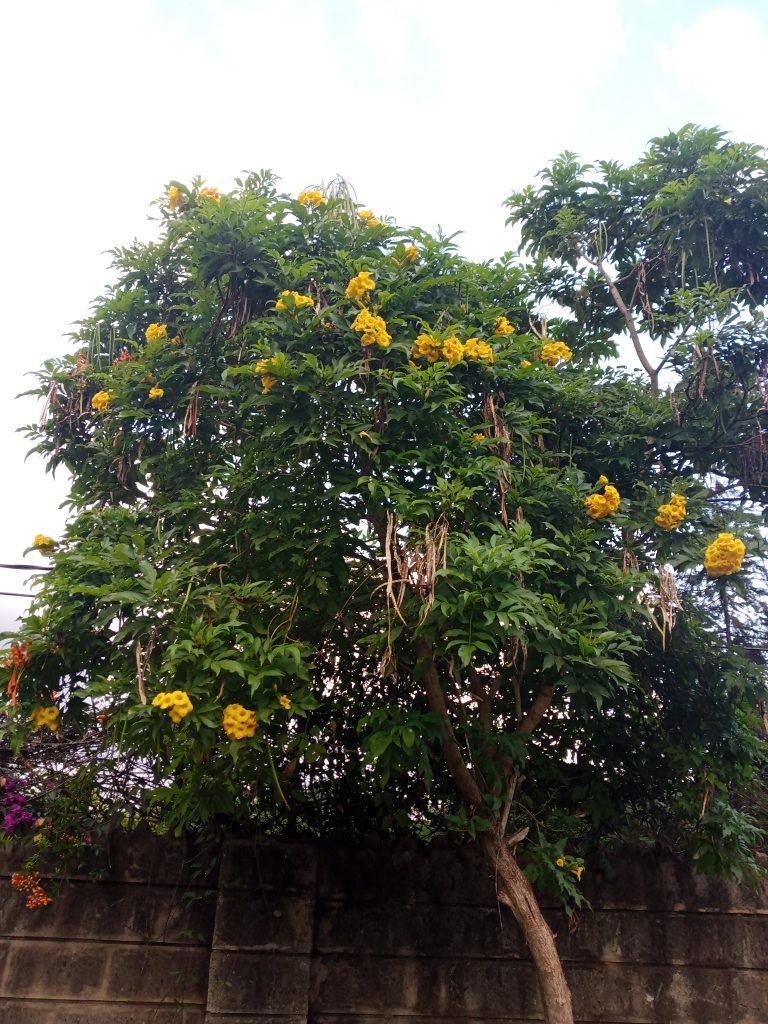
4. Tecoma stans-Tecomaria, Yellow bells, Trumpet bush
This small tree has funnel-shaped bright yellow flowers that draw attention. It can be an open tree or shrub with several slim trunks. The tecoma is ideal because it can be grown in a container on a balcony as long as it receives full sun. Rarely grows beyond 3 metres.
Water tecoma freely during early growth. Sow seeds or make cutting from semi hard branches.
5. Bottle brush (Callistemon)
Bottle brush is endemic to Australia but has been naturalized around the world. It is dense and multi-trunked with low branching pendulous growth. It is drought tolerant and therefore suitable for the dry areas.
Bottle brush trees are grown for their colourful terminal or auxiliary bottle –brush like spikes of tiny flowers that can be pink, red, purple, white, green or yellow. Locally though the white, pink and red flower trees are the most common.
Grow in full sun in well drained neutral to acidic moderately fertile soil. It is propagated from seeds and semi ripe cuttings.
6. Loquat (Eriobotrya japonica)
So common place that it is hard to imagine this fruit tree is a native of Himalayas and East Asia. It is grown commercially for its juicy orange-yellow fruit. It has scented flowers and glossy green leaves.
row in full sun to 8 m high.
7. Bauhinia variegata (Orchid tree)
This is a spreading tree with rounded rich green leaves with heart shaped bases. It bears light magenta –purple-blue flowers for which the tree is mostly grown. Bauhinia may require restrictive pruning.
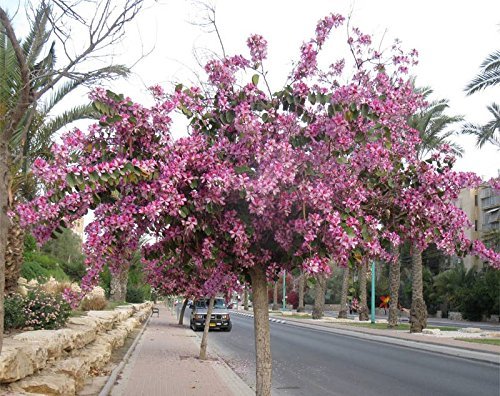
8. Cape chestnut (Calodendrum capense)
The Cape chestnut is a magnificent sight to behold when in flower. In full flower the entire canopy turns pink. So enthralled with its beauty was Carl Peter Thunberg that he shot severally at the branches until a bloom dropped into his hands, famously naming the tree as Calodendrum, “beautiful tree.” It is from the Cape in South Africa.
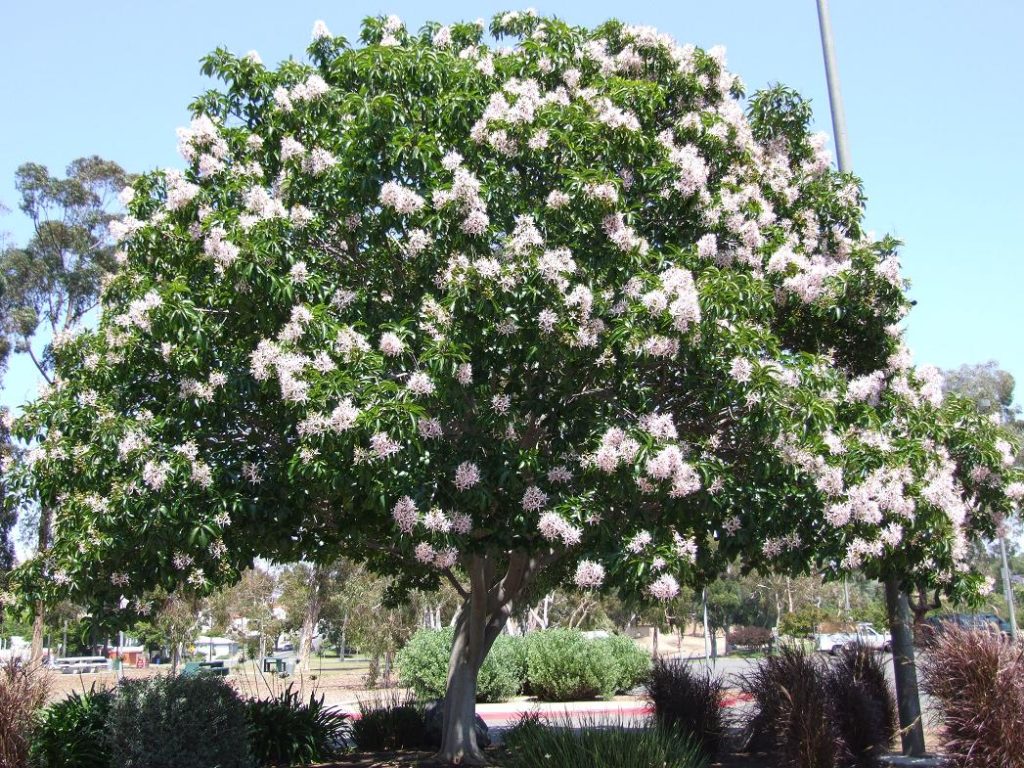
Cape chestnut is a good ornamental tree used as a specimen plant for its large and string flowers or for shade in the garden. When crushed and boiled the seeds give oils useful for soap making. The bark has medicinal value and is used as a component of skin ointments. Traditionally hunters used to carry the seeds in the belief it would bring them skill and good luck. It is propagated by seeds or cuttings. When grown in cold regions, it does not flower profusely. While in the forest it can grow to 20m, in open cultivation the tree rarely grows beyond 7 m high.
9. Ficus Benjamina
Long derided as a troublesome tree in parking and pavements, Ficus has been unfairly treated. If you are pressed for space, this tree comes in handy because it is can be customized to fit your space by limiting its growth through shaping. You can turn it into square, spherical or circular forms therefore adding interest to the garden. In addition restrictive pruning can also render it harmless in a small space. Its variant, Ficus Variegata has white splashed leaves that make for a perfect postcard picture!
More importantly Ficus in a pot will snugly fit onto your balcony space or porch.

10. Italian Cypress(Cupresses semperiverens ‘stricta”)
Even for the smallest gardens, the Italian cypress will fit. Slow growing, the tree can take the thinnest of spaces taking less than 1 meter wide. If you so wish you can limit its upper growth by chopping off the top at the desired height. Several trees lined together give off a Mediterranean appeal due to its conical or columnar shape. Again a good candidate for the pot!
11. Ipomoea arborescens, (Tree morning glory”, Mexican bush morning)
When you encounter this tree for the first time while in its glory phase, you will be awed by the spectacular display of flower that seems to swamp it. While the Ipomoea family is famously known for its morning glory vines and twining climbers, there exist a few shrubs and trees in the group. Ipomoea arborescens is the only tree I have come across so far and as garden tree, it does pass muster. Its dazzling flowers are often trumpet shaped and often occur in pink although white and lavender varieties exist. The leaves are glossy dark green. Average growth height is 5meters (16feet). The tree flowers during the warmer months of between spring and autumn in the temperate regions and during the hot season in the tropics.

Plant Ipomea in a sunny or partially shaded spot. The soil should be well-drained soil and rich. Regularly prune to keep it tidy and well structured.
12. Bottle brush (Callistemon citrus)
This is a popular tree grown that thrives in many regions across the globe. It main attraction is the attractive flowers and foliage. Originally from Australia, it is an evergreen tree that grows to 5 Meters (16 feet). This makes it ideal for small gardens. The common types are the red flowering one but there are white, yellow and pink flowering varieties. Bottle brush has dark green foliage and the cylindrical spikes of the flower give the tree is common name of “bottle brush”. Expect flowering between spring and autumn and throughout in the tropics.

13. Thuja occidentalis (Eastern arborvitae, White cedar)
This native of North America is favorite for small gardens. It is beloved because of its foliage and growth habits. The green leaves, may turn white or yellow in cold season. Its feathery appearance is due to its scale like-leaves that are arranged in a flattened pattern.
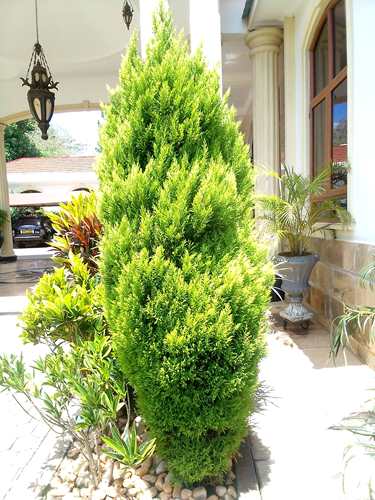
If you get dwarf varieties like Danica” and Techny, you can be assured of everlasting container plants suitable for the balcony, patio or deck. The beauty with thuja is that it tolerates both sand and clay soil although it optimum growing soil should be acidic in pH range.
14. Lagerstroemia indica (Crape myrtle)
Lagerstroemias are cultivated for their conical brightly coloured panicles of flowers, their characteristic crinkled petals and their often peeling bark. Lagerstroemia indica is has dark green leaves that appear bronze when young. It is upright, deciduous and grows both in the warm-temperate and tropical regions. White, pink, red or purple flowers will abound in summer through autumn.
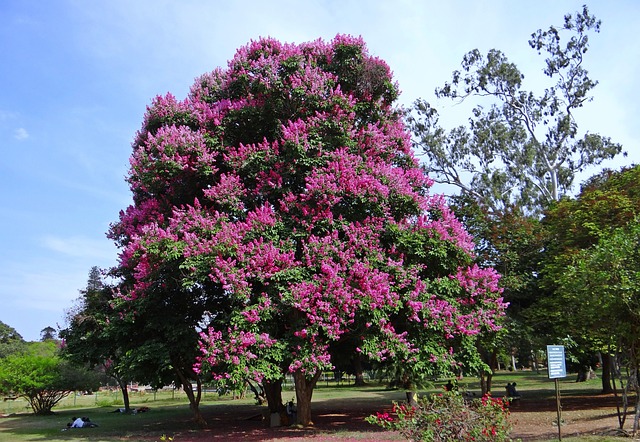
Ideal for small spaces as it rarely grows beyond 8m.
There are species considered cultivars that rarely grow beyond 2meters. Such cultivars include;
Catawba-produces purple flowers and orange red-autumn leaves
Dallas red-hardy and fast growing with dark green leaves
Lavender dwarf-Spreading and with mass of light-lavender –purple flowers . Maximum growth is 2 meters (7ft).
15. Magnolia grandiflora
This spreading deciduous tree has dark green leaves that are bronze-red when young and will turn red and yellow during autumn. A profusion of cup like shaped white flowers emerges in spring to be succeeded by ovoid cherry-like magenta-red fruit.

In Japan, the cherry tree is usually used to set date of events; I recall a period ten years ago when some office parties that had been pegged on the regular flowering of the cherry had to be postponed as the flowering delayed.
On average the cherry tree will grow between 5-12 meters (16-40 ft.) they prefer full sun in well-drained soil. Regular watering will help.
16. Eastern Redbud (Cercis Canadensis)
Cercis have traditionally thrived around the Mediterranean region, Central and East Asia and North America.. They are characterized by heart –shaped leaves and brightly colored pea-like flowers that are produced on previous year’s growth.
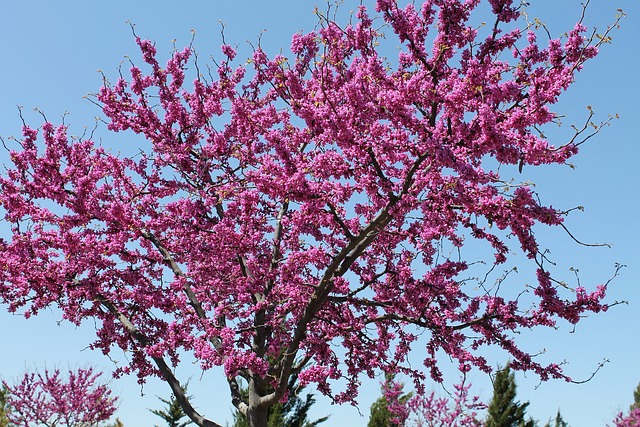
C. canadensis are spreading, multi- stemmed trees whose young leaves appear bronze and turn yellow in Autumn. The flowers are borne in clusters of 2-8 on bare stems.
Maximum growth height is 10 meters (30ft)
Forest pansy has dark red –purple leaves wile Royal white bears a profusion of pure white flowers.
Grow Cercis in full sun in loam soil. Plant in the final location when young as older trees are averse to transplanting.
17. Acer (Maple trees)
Acers are evergreen and deciduous trees from N. Africa, Europe and Asia Central and North America. The beauty of maples is in their leaves which can be variegated or give off splendid autumn color.
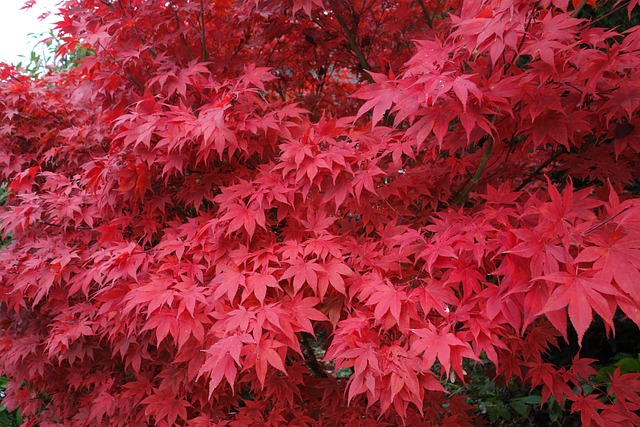
If you get larger varieties, grow then in containers. This restricts their growth. Some frost hardy. Grow in fertile moist and well drained soils. Some larger species can also be trained as central leader standards.
The Japanese maple (Acer palpatum) is the most and it cultivars the most maple found in gardens around the globe popular varieties. It is a round headed deciduous tree with mid green delicate leaves that strikingly turn orange, yellow to red in autumn.
Most Acers are full hardy with a few being frost tender.
Grow acers in sun or partial shade. The soil should be well drained and fertile. Mulch the roots of Ac. palpatum and A. japonicum and their cultivars in spring. Protect both types from strong wind or late frost as it may kill the young leaves.
18. Malus( crab apple)
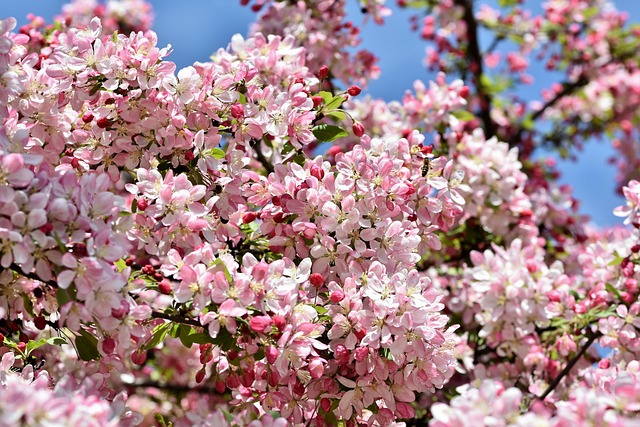
Crab apples are grown for their fragrant flowers and attractive almost spherical fruits. They form good specimen trees suitable for gardens. Most crab apples will rarely grow beyond 6 m.
19. Cornus(Dogwood)
Dogwood trees are gown for their showy bracts of star-shaped flowers, elegant habit, fruits and colorful autumn leaves. They serve well as specimen trees. If you have a small woodland garden and you want feature trees, dogwoods ate your go to choice. I particularly like C. pollard for their purple and green flowers that occur in spring. Pollard does not grow beyond 10 and is fairly a slow grower. Another useful dogwood is the Cornus controversa whose dark leaves turn rich red and purple in autumn.
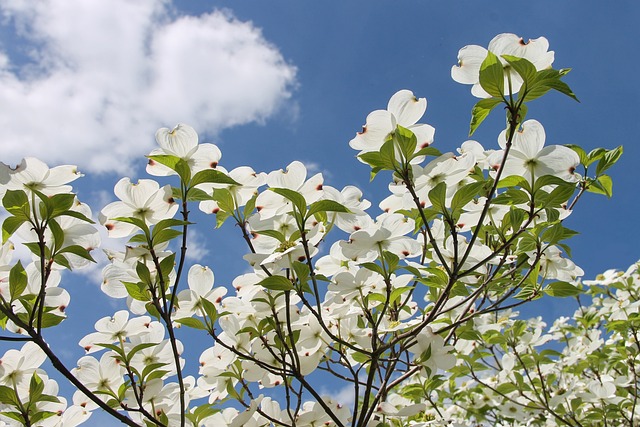
20. Fruit trees (Dwarf varieties)
With fruit trees you kill two birds with one stone. You enjoy trees for their ornamental value and get to have fruits from your own garden. Smaller varieties of apple, Citrus, peach,guava and mango are ideal in smaller urban gardens where they can even thrive in pots. Lemons give off a wonderful scent, for which it was traditionally gown in the middle ages.





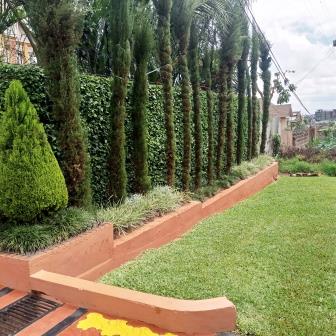
Leave a Reply